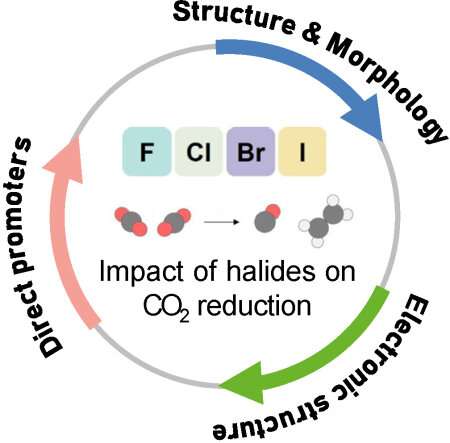Researchers review impact of halides on electrochemical carbon dioxide reduction

Halides hold promise for improving the performance of catalysts used in carbon dioxide conversion. A team of scientists has examined the recent progress and challenges related to halides, and provided their outlook on future directions for the research.
The team published their findings in a review paper in the journal Nano Research Energy on November 30, 2022.
Scientists are looking to electrochemical carbon dioxide reduction reaction (CO2RR) as a promising technology to help ease global warming and to store renewable energy. For this technology to be successful and low-cost, efficient electrocatalysts are required. Despite the potential CO2RR holds, its use is currently limited because of catalyst activity and selectivity, system efficiency, and understanding of reaction pathways.
There is a strong need for the development of an electrocatalyst with high activity and selectivity in order for CO2 electroreduction technology to find practical applications.
Therefore the research team undertook a comprehensive review of the role and mechanism of halide ions in the CO2RR process to help better guide the future design of efficient electrocatalysts. "The ultimate goal is to design more efficient and active catalysts for the conversion of CO2 into value-added chemicals and fuels. There are strong applications in carbon utilization," said Yanwei Lum, a researcher at the Institute of Materials Research and Engineering, Agency for Science, Technology and Research.
In their review, the team explored the role of halide ions on the structure and morphology of electrocatalysts. Next, they examined the relationship between the halide ions and the valence states of the active sites on the catalyst surface. Then they summarized the mechanisms of halide in enhancing CO2 conversion efficiency, including the way halide ions are involved in electron transfer and their influence on the reaction pathway. They conclude their study with a summary and future outlook. "We wish to spotlight and encourage further research on the incorporation and interaction of halogen elements with CO2 conversion catalysts," said Lum.
The team highlights three areas that they believe warrant in-depth investigation and research. First, the team recommends the design of model systems to identify key mechanisms in different situations. The team has classified mechanisms by which halides contribute to electrochemical CO2 reduction under nanostructure reorganization, modulation of electronic structure, and direct promotion.
However, these factors can all impact the catalyst simultaneously, which makes it difficult to distinguish the key ones at play. Therefore, to gain insight into the role of halide ions in CO2 reduction reactions, the team sees the necessity to systematically design well-defined model systems to study the key mechanisms for each case.
Their second recommendation is to develop advanced in-situ characterization tools to better understand the role of halides. Under reaction conditions, the catalyst surface structure, active sites, valence state and reaction intermediates could be dynamically changing. However, these dynamic changes often occur for extremely short periods, and the role of halides in the process may not be fully reflected by ex-situ studies.
So the team recommends that advanced in-situ characterizations and methods should be used for measuring the catalyst surface and structure changes. For example, in-situ X-ray absorption spectroscopy could be used to study the oxidation state of the catalyst under reaction conditions. In-situ transmission electron microscopy could be used to observe how the nanostructure of the catalyst changes during CO2 reduction.
Their third recommendation is to explore new halide-based catalyst architectures. Up to now, research has focused on developing halide modified metal-based electrocatalysts. Beyond such systems, there may be other opportunities for the design of new types of electrocatalysts. For example, doping of halogens into carbon-based catalysts and using organic halide compounds as molecular additives to enhance electrocatalytic activity could become new highly promising avenues for exploration.
More information: Zebi Zhao et al, Reviewing the impact of halides on electrochemical CO2 reduction, Nano Research Energy (2022). DOI: 10.26599/NRE.2023.9120044
Provided by Tsinghua University Press



















